The Use of Sacrifices for Cleansing and Bringing People Closer to God
VerifiedAdded on 2022/11/23
|7
|1928
|151
AI Summary
This article explores the use of sacrifices in the Old and New Testament for cleansing and bringing people closer to God. It discusses the significance of animal sacrifices in the Old Testament, the role of sacrifices in the letters of Paul, and the portrayal of sacrifices in the New Testament Gospels. The article concludes by discussing the connection between the death and resurrection of Jesus Christ and the Old Testament sacrifices.
Contribute Materials
Your contribution can guide someone’s learning journey. Share your
documents today.
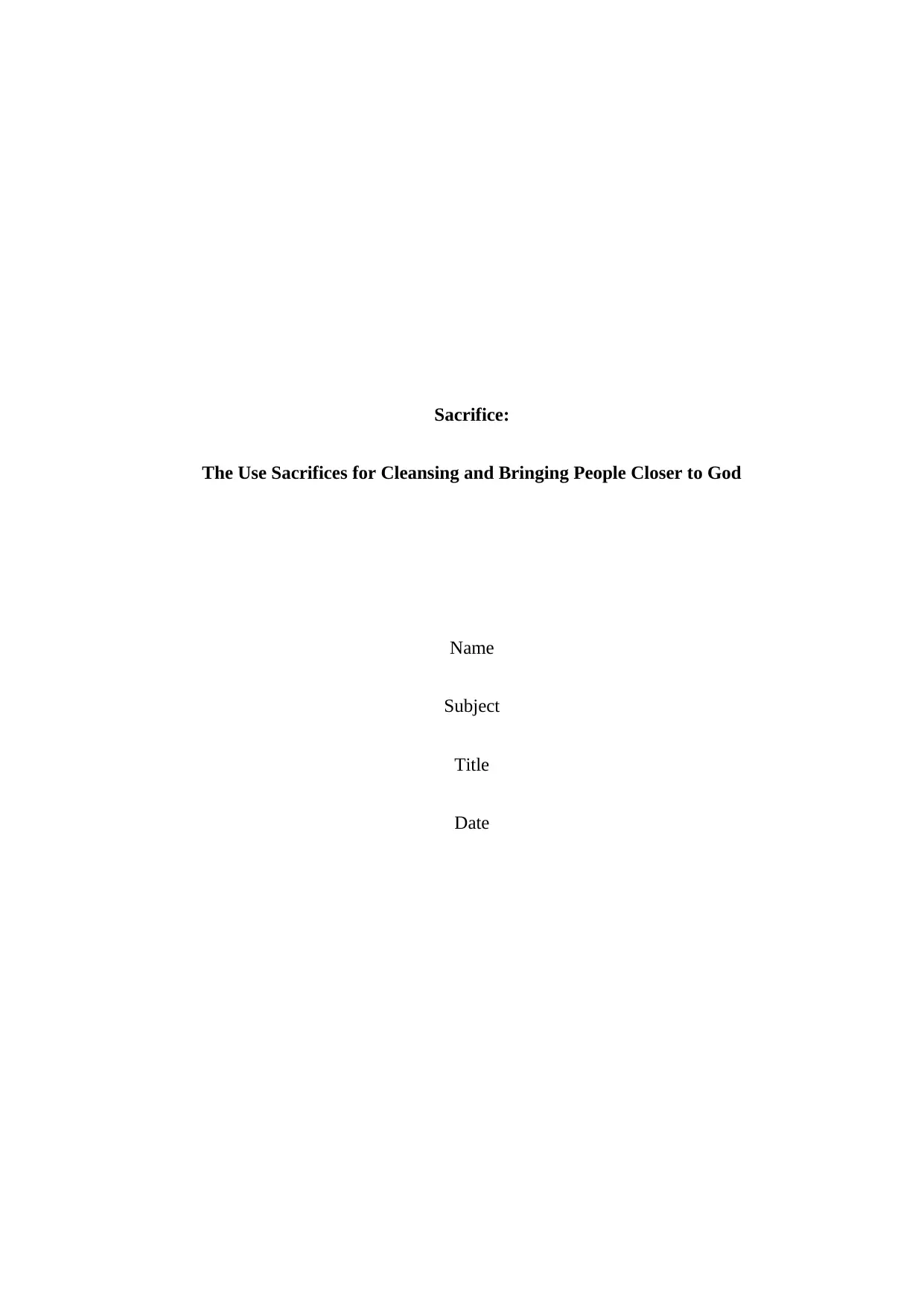
Sacrifice:
The Use Sacrifices for Cleansing and Bringing People Closer to God
Name
Subject
Title
Date
The Use Sacrifices for Cleansing and Bringing People Closer to God
Name
Subject
Title
Date
Secure Best Marks with AI Grader
Need help grading? Try our AI Grader for instant feedback on your assignments.
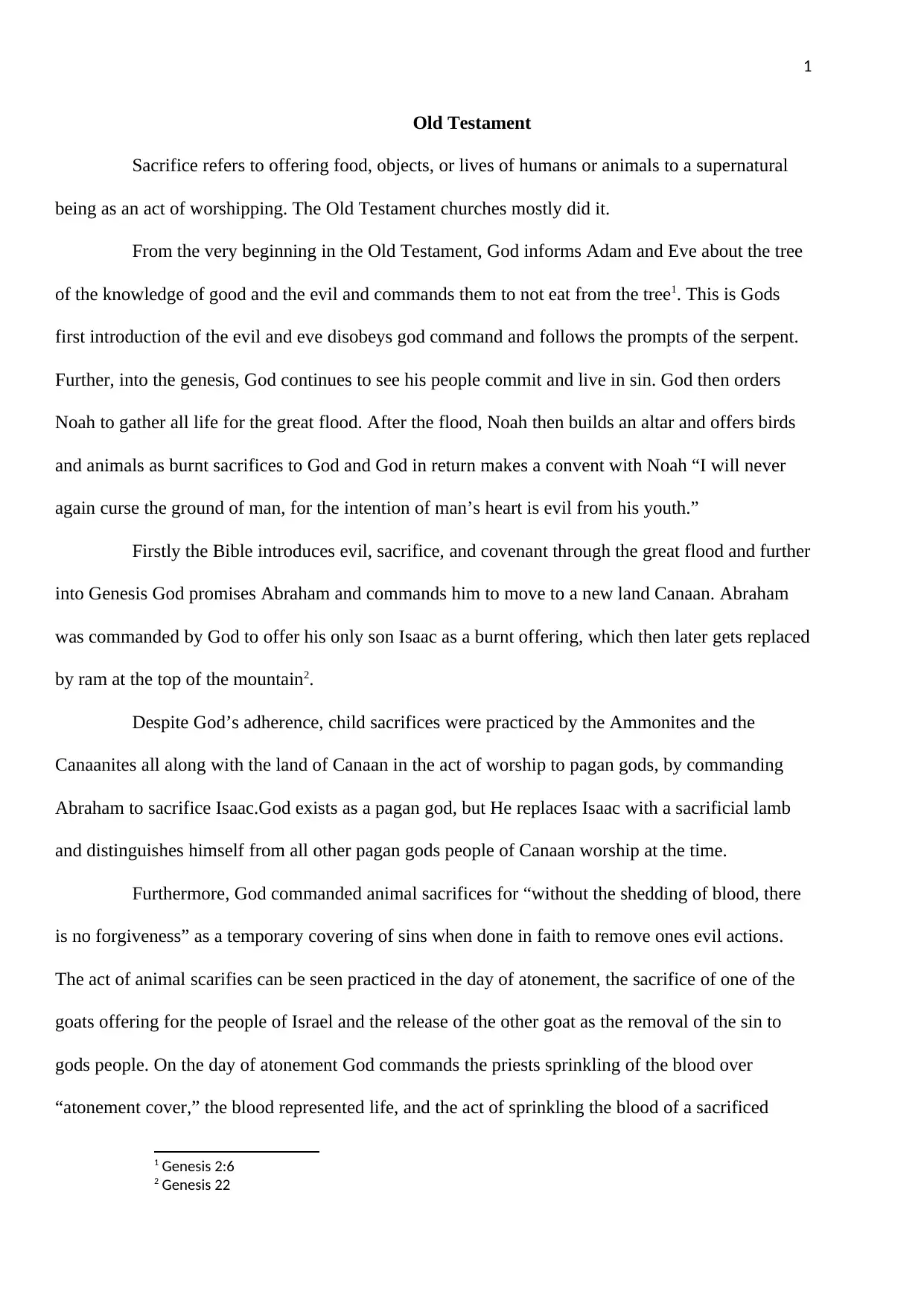
1
Old Testament
Sacrifice refers to offering food, objects, or lives of humans or animals to a supernatural
being as an act of worshipping. The Old Testament churches mostly did it.
From the very beginning in the Old Testament, God informs Adam and Eve about the tree
of the knowledge of good and the evil and commands them to not eat from the tree1. This is Gods
first introduction of the evil and eve disobeys god command and follows the prompts of the serpent.
Further, into the genesis, God continues to see his people commit and live in sin. God then orders
Noah to gather all life for the great flood. After the flood, Noah then builds an altar and offers birds
and animals as burnt sacrifices to God and God in return makes a convent with Noah “I will never
again curse the ground of man, for the intention of man’s heart is evil from his youth.”
Firstly the Bible introduces evil, sacrifice, and covenant through the great flood and further
into Genesis God promises Abraham and commands him to move to a new land Canaan. Abraham
was commanded by God to offer his only son Isaac as a burnt offering, which then later gets replaced
by ram at the top of the mountain2.
Despite God’s adherence, child sacrifices were practiced by the Ammonites and the
Canaanites all along with the land of Canaan in the act of worship to pagan gods, by commanding
Abraham to sacrifice Isaac.God exists as a pagan god, but He replaces Isaac with a sacrificial lamb
and distinguishes himself from all other pagan gods people of Canaan worship at the time.
Furthermore, God commanded animal sacrifices for “without the shedding of blood, there
is no forgiveness” as a temporary covering of sins when done in faith to remove ones evil actions.
The act of animal scarifies can be seen practiced in the day of atonement, the sacrifice of one of the
goats offering for the people of Israel and the release of the other goat as the removal of the sin to
gods people. On the day of atonement God commands the priests sprinkling of the blood over
“atonement cover,” the blood represented life, and the act of sprinkling the blood of a sacrificed
1 Genesis 2:6
2 Genesis 22
Old Testament
Sacrifice refers to offering food, objects, or lives of humans or animals to a supernatural
being as an act of worshipping. The Old Testament churches mostly did it.
From the very beginning in the Old Testament, God informs Adam and Eve about the tree
of the knowledge of good and the evil and commands them to not eat from the tree1. This is Gods
first introduction of the evil and eve disobeys god command and follows the prompts of the serpent.
Further, into the genesis, God continues to see his people commit and live in sin. God then orders
Noah to gather all life for the great flood. After the flood, Noah then builds an altar and offers birds
and animals as burnt sacrifices to God and God in return makes a convent with Noah “I will never
again curse the ground of man, for the intention of man’s heart is evil from his youth.”
Firstly the Bible introduces evil, sacrifice, and covenant through the great flood and further
into Genesis God promises Abraham and commands him to move to a new land Canaan. Abraham
was commanded by God to offer his only son Isaac as a burnt offering, which then later gets replaced
by ram at the top of the mountain2.
Despite God’s adherence, child sacrifices were practiced by the Ammonites and the
Canaanites all along with the land of Canaan in the act of worship to pagan gods, by commanding
Abraham to sacrifice Isaac.God exists as a pagan god, but He replaces Isaac with a sacrificial lamb
and distinguishes himself from all other pagan gods people of Canaan worship at the time.
Furthermore, God commanded animal sacrifices for “without the shedding of blood, there
is no forgiveness” as a temporary covering of sins when done in faith to remove ones evil actions.
The act of animal scarifies can be seen practiced in the day of atonement, the sacrifice of one of the
goats offering for the people of Israel and the release of the other goat as the removal of the sin to
gods people. On the day of atonement God commands the priests sprinkling of the blood over
“atonement cover,” the blood represented life, and the act of sprinkling the blood of a sacrificed
1 Genesis 2:6
2 Genesis 22
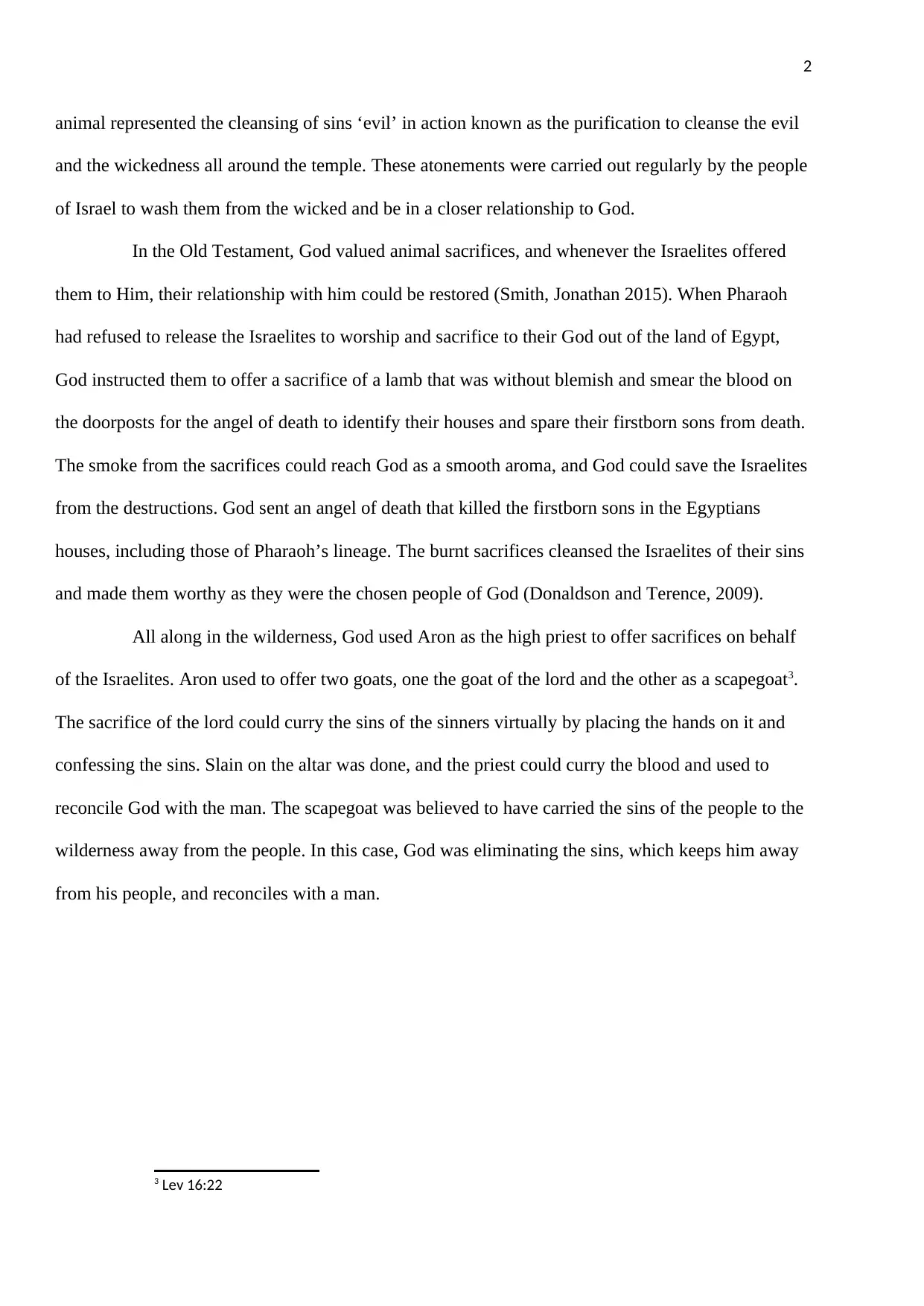
2
animal represented the cleansing of sins ‘evil’ in action known as the purification to cleanse the evil
and the wickedness all around the temple. These atonements were carried out regularly by the people
of Israel to wash them from the wicked and be in a closer relationship to God.
In the Old Testament, God valued animal sacrifices, and whenever the Israelites offered
them to Him, their relationship with him could be restored (Smith, Jonathan 2015). When Pharaoh
had refused to release the Israelites to worship and sacrifice to their God out of the land of Egypt,
God instructed them to offer a sacrifice of a lamb that was without blemish and smear the blood on
the doorposts for the angel of death to identify their houses and spare their firstborn sons from death.
The smoke from the sacrifices could reach God as a smooth aroma, and God could save the Israelites
from the destructions. God sent an angel of death that killed the firstborn sons in the Egyptians
houses, including those of Pharaoh’s lineage. The burnt sacrifices cleansed the Israelites of their sins
and made them worthy as they were the chosen people of God (Donaldson and Terence, 2009).
All along in the wilderness, God used Aron as the high priest to offer sacrifices on behalf
of the Israelites. Aron used to offer two goats, one the goat of the lord and the other as a scapegoat3.
The sacrifice of the lord could curry the sins of the sinners virtually by placing the hands on it and
confessing the sins. Slain on the altar was done, and the priest could curry the blood and used to
reconcile God with the man. The scapegoat was believed to have carried the sins of the people to the
wilderness away from the people. In this case, God was eliminating the sins, which keeps him away
from his people, and reconciles with a man.
3 Lev 16:22
animal represented the cleansing of sins ‘evil’ in action known as the purification to cleanse the evil
and the wickedness all around the temple. These atonements were carried out regularly by the people
of Israel to wash them from the wicked and be in a closer relationship to God.
In the Old Testament, God valued animal sacrifices, and whenever the Israelites offered
them to Him, their relationship with him could be restored (Smith, Jonathan 2015). When Pharaoh
had refused to release the Israelites to worship and sacrifice to their God out of the land of Egypt,
God instructed them to offer a sacrifice of a lamb that was without blemish and smear the blood on
the doorposts for the angel of death to identify their houses and spare their firstborn sons from death.
The smoke from the sacrifices could reach God as a smooth aroma, and God could save the Israelites
from the destructions. God sent an angel of death that killed the firstborn sons in the Egyptians
houses, including those of Pharaoh’s lineage. The burnt sacrifices cleansed the Israelites of their sins
and made them worthy as they were the chosen people of God (Donaldson and Terence, 2009).
All along in the wilderness, God used Aron as the high priest to offer sacrifices on behalf
of the Israelites. Aron used to offer two goats, one the goat of the lord and the other as a scapegoat3.
The sacrifice of the lord could curry the sins of the sinners virtually by placing the hands on it and
confessing the sins. Slain on the altar was done, and the priest could curry the blood and used to
reconcile God with the man. The scapegoat was believed to have carried the sins of the people to the
wilderness away from the people. In this case, God was eliminating the sins, which keeps him away
from his people, and reconciles with a man.
3 Lev 16:22
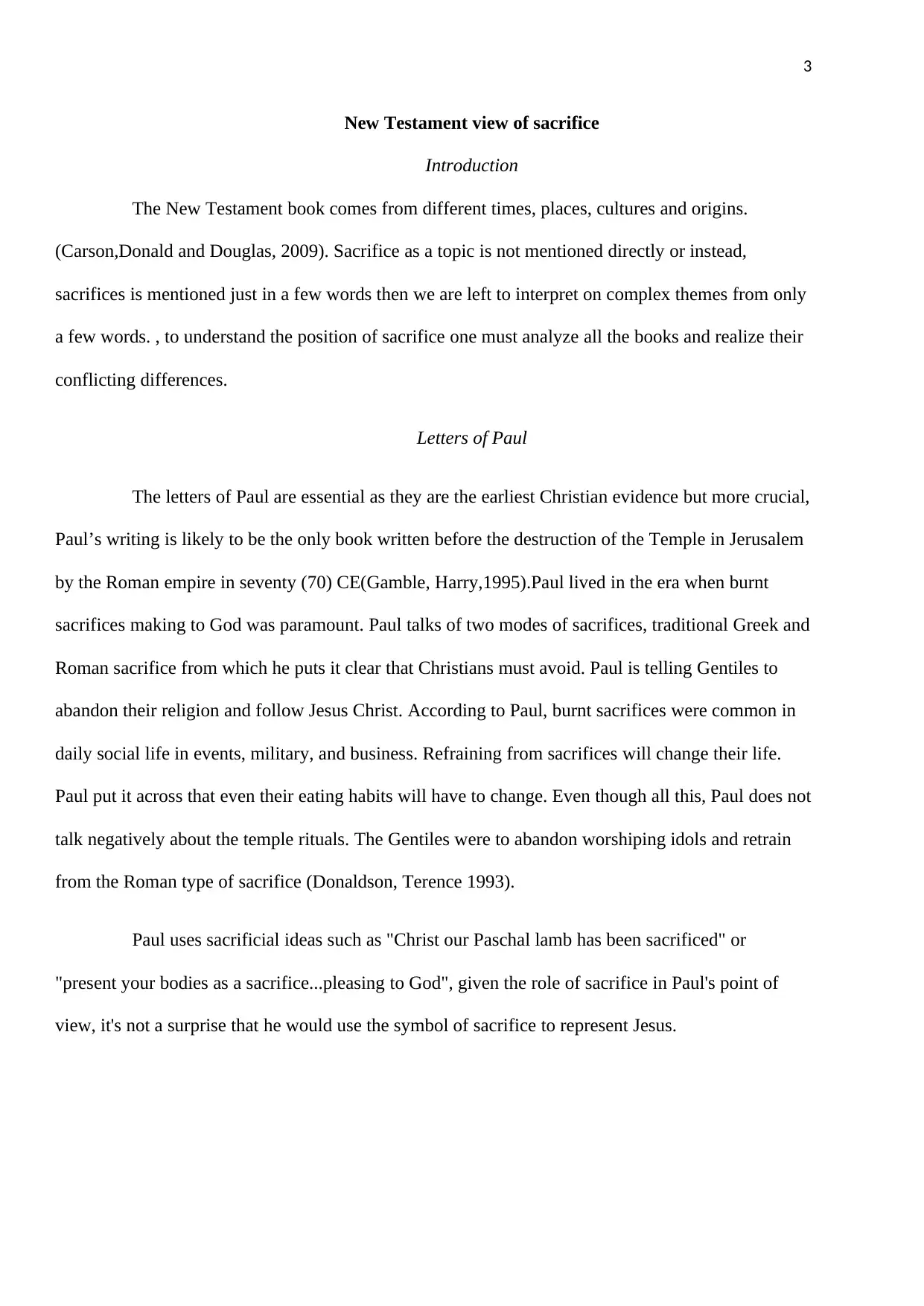
3
New Testament view of sacrifice
Introduction
The New Testament book comes from different times, places, cultures and origins.
(Carson,Donald and Douglas, 2009). Sacrifice as a topic is not mentioned directly or instead,
sacrifices is mentioned just in a few words then we are left to interpret on complex themes from only
a few words. , to understand the position of sacrifice one must analyze all the books and realize their
conflicting differences.
Letters of Paul
The letters of Paul are essential as they are the earliest Christian evidence but more crucial,
Paul’s writing is likely to be the only book written before the destruction of the Temple in Jerusalem
by the Roman empire in seventy (70) CE(Gamble, Harry,1995).Paul lived in the era when burnt
sacrifices making to God was paramount. Paul talks of two modes of sacrifices, traditional Greek and
Roman sacrifice from which he puts it clear that Christians must avoid. Paul is telling Gentiles to
abandon their religion and follow Jesus Christ. According to Paul, burnt sacrifices were common in
daily social life in events, military, and business. Refraining from sacrifices will change their life.
Paul put it across that even their eating habits will have to change. Even though all this, Paul does not
talk negatively about the temple rituals. The Gentiles were to abandon worshiping idols and retrain
from the Roman type of sacrifice (Donaldson, Terence 1993).
Paul uses sacrificial ideas such as "Christ our Paschal lamb has been sacrificed" or
"present your bodies as a sacrifice...pleasing to God", given the role of sacrifice in Paul's point of
view, it's not a surprise that he would use the symbol of sacrifice to represent Jesus.
New Testament view of sacrifice
Introduction
The New Testament book comes from different times, places, cultures and origins.
(Carson,Donald and Douglas, 2009). Sacrifice as a topic is not mentioned directly or instead,
sacrifices is mentioned just in a few words then we are left to interpret on complex themes from only
a few words. , to understand the position of sacrifice one must analyze all the books and realize their
conflicting differences.
Letters of Paul
The letters of Paul are essential as they are the earliest Christian evidence but more crucial,
Paul’s writing is likely to be the only book written before the destruction of the Temple in Jerusalem
by the Roman empire in seventy (70) CE(Gamble, Harry,1995).Paul lived in the era when burnt
sacrifices making to God was paramount. Paul talks of two modes of sacrifices, traditional Greek and
Roman sacrifice from which he puts it clear that Christians must avoid. Paul is telling Gentiles to
abandon their religion and follow Jesus Christ. According to Paul, burnt sacrifices were common in
daily social life in events, military, and business. Refraining from sacrifices will change their life.
Paul put it across that even their eating habits will have to change. Even though all this, Paul does not
talk negatively about the temple rituals. The Gentiles were to abandon worshiping idols and retrain
from the Roman type of sacrifice (Donaldson, Terence 1993).
Paul uses sacrificial ideas such as "Christ our Paschal lamb has been sacrificed" or
"present your bodies as a sacrifice...pleasing to God", given the role of sacrifice in Paul's point of
view, it's not a surprise that he would use the symbol of sacrifice to represent Jesus.
Secure Best Marks with AI Grader
Need help grading? Try our AI Grader for instant feedback on your assignments.
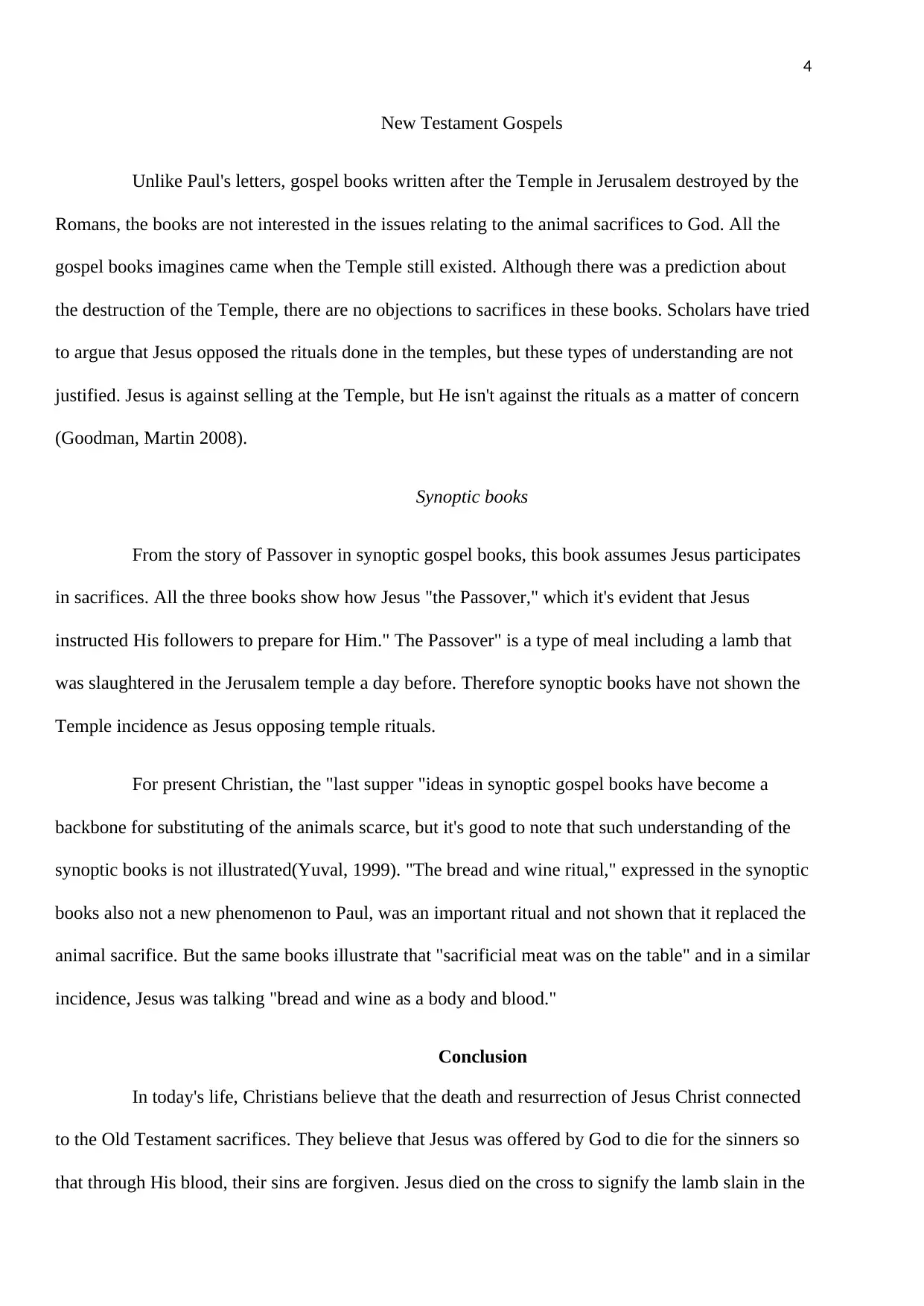
4
New Testament Gospels
Unlike Paul's letters, gospel books written after the Temple in Jerusalem destroyed by the
Romans, the books are not interested in the issues relating to the animal sacrifices to God. All the
gospel books imagines came when the Temple still existed. Although there was a prediction about
the destruction of the Temple, there are no objections to sacrifices in these books. Scholars have tried
to argue that Jesus opposed the rituals done in the temples, but these types of understanding are not
justified. Jesus is against selling at the Temple, but He isn't against the rituals as a matter of concern
(Goodman, Martin 2008).
Synoptic books
From the story of Passover in synoptic gospel books, this book assumes Jesus participates
in sacrifices. All the three books show how Jesus "the Passover," which it's evident that Jesus
instructed His followers to prepare for Him." The Passover" is a type of meal including a lamb that
was slaughtered in the Jerusalem temple a day before. Therefore synoptic books have not shown the
Temple incidence as Jesus opposing temple rituals.
For present Christian, the "last supper "ideas in synoptic gospel books have become a
backbone for substituting of the animals scarce, but it's good to note that such understanding of the
synoptic books is not illustrated(Yuval, 1999). "The bread and wine ritual," expressed in the synoptic
books also not a new phenomenon to Paul, was an important ritual and not shown that it replaced the
animal sacrifice. But the same books illustrate that "sacrificial meat was on the table" and in a similar
incidence, Jesus was talking "bread and wine as a body and blood."
Conclusion
In today's life, Christians believe that the death and resurrection of Jesus Christ connected
to the Old Testament sacrifices. They believe that Jesus was offered by God to die for the sinners so
that through His blood, their sins are forgiven. Jesus died on the cross to signify the lamb slain in the
New Testament Gospels
Unlike Paul's letters, gospel books written after the Temple in Jerusalem destroyed by the
Romans, the books are not interested in the issues relating to the animal sacrifices to God. All the
gospel books imagines came when the Temple still existed. Although there was a prediction about
the destruction of the Temple, there are no objections to sacrifices in these books. Scholars have tried
to argue that Jesus opposed the rituals done in the temples, but these types of understanding are not
justified. Jesus is against selling at the Temple, but He isn't against the rituals as a matter of concern
(Goodman, Martin 2008).
Synoptic books
From the story of Passover in synoptic gospel books, this book assumes Jesus participates
in sacrifices. All the three books show how Jesus "the Passover," which it's evident that Jesus
instructed His followers to prepare for Him." The Passover" is a type of meal including a lamb that
was slaughtered in the Jerusalem temple a day before. Therefore synoptic books have not shown the
Temple incidence as Jesus opposing temple rituals.
For present Christian, the "last supper "ideas in synoptic gospel books have become a
backbone for substituting of the animals scarce, but it's good to note that such understanding of the
synoptic books is not illustrated(Yuval, 1999). "The bread and wine ritual," expressed in the synoptic
books also not a new phenomenon to Paul, was an important ritual and not shown that it replaced the
animal sacrifice. But the same books illustrate that "sacrificial meat was on the table" and in a similar
incidence, Jesus was talking "bread and wine as a body and blood."
Conclusion
In today's life, Christians believe that the death and resurrection of Jesus Christ connected
to the Old Testament sacrifices. They believe that Jesus was offered by God to die for the sinners so
that through His blood, their sins are forgiven. Jesus died on the cross to signify the lamb slain in the
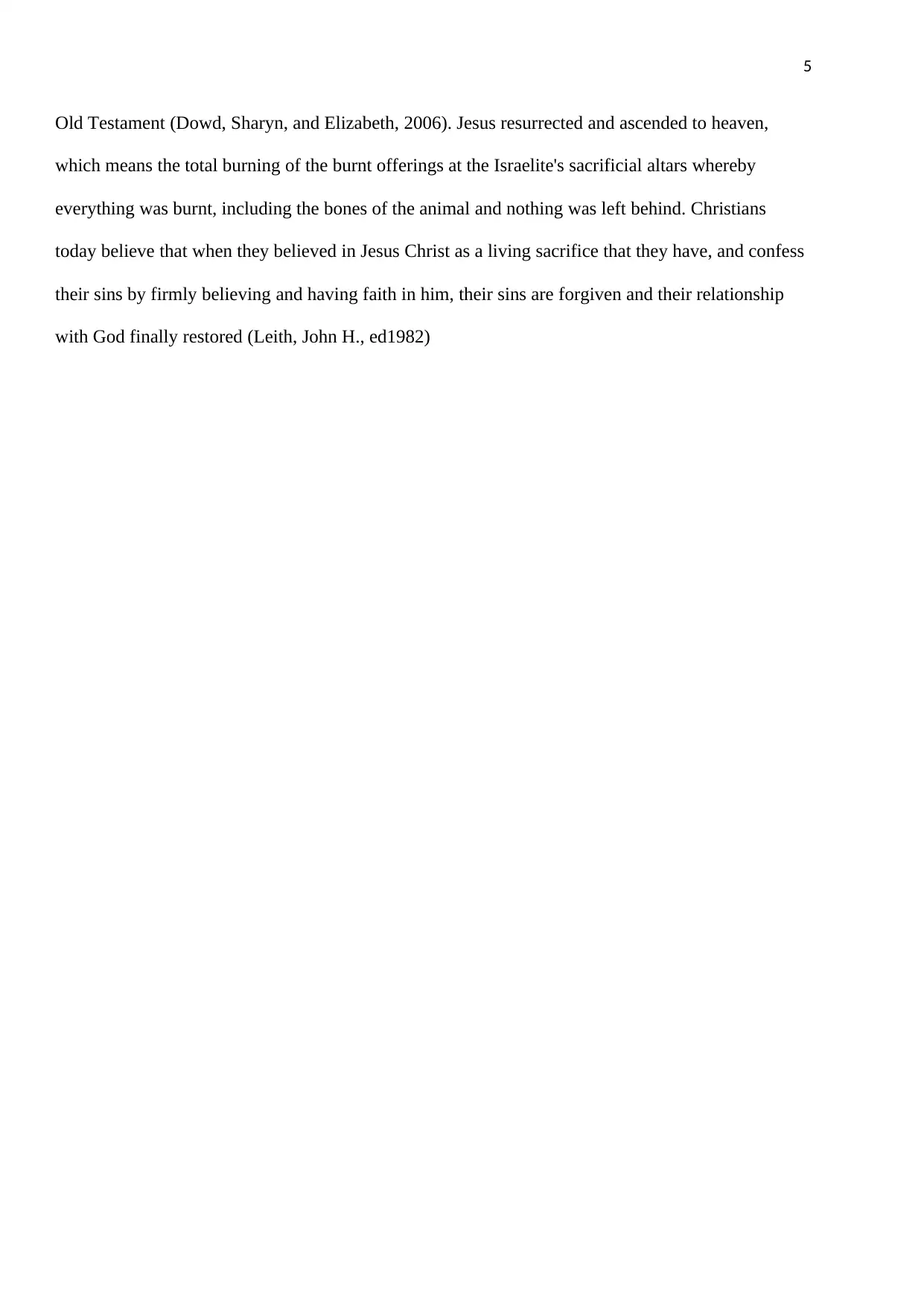
5
Old Testament (Dowd, Sharyn, and Elizabeth, 2006). Jesus resurrected and ascended to heaven,
which means the total burning of the burnt offerings at the Israelite's sacrificial altars whereby
everything was burnt, including the bones of the animal and nothing was left behind. Christians
today believe that when they believed in Jesus Christ as a living sacrifice that they have, and confess
their sins by firmly believing and having faith in him, their sins are forgiven and their relationship
with God finally restored (Leith, John H., ed1982)
Old Testament (Dowd, Sharyn, and Elizabeth, 2006). Jesus resurrected and ascended to heaven,
which means the total burning of the burnt offerings at the Israelite's sacrificial altars whereby
everything was burnt, including the bones of the animal and nothing was left behind. Christians
today believe that when they believed in Jesus Christ as a living sacrifice that they have, and confess
their sins by firmly believing and having faith in him, their sins are forgiven and their relationship
with God finally restored (Leith, John H., ed1982)
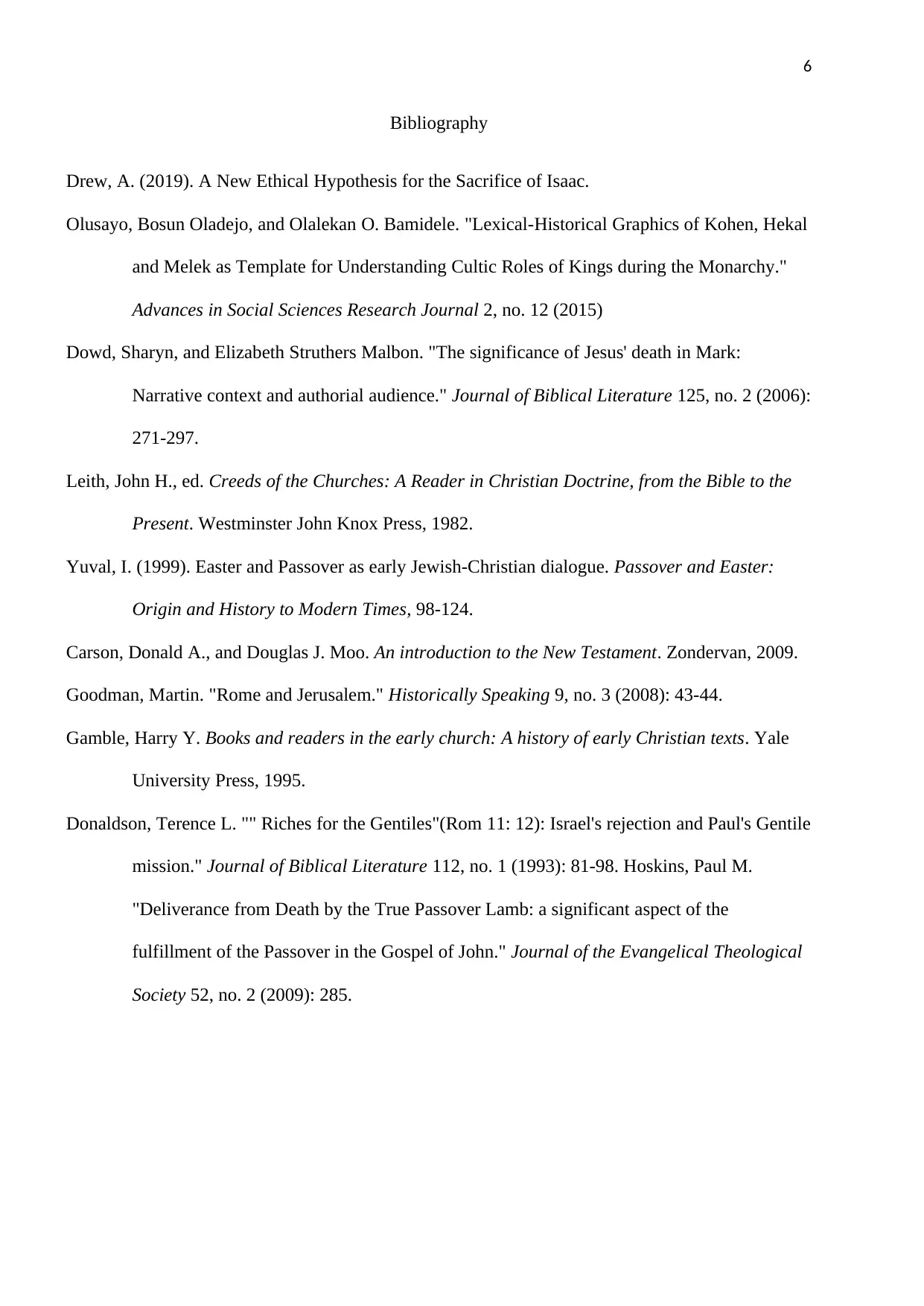
6
Bibliography
Drew, A. (2019). A New Ethical Hypothesis for the Sacrifice of Isaac.
Olusayo, Bosun Oladejo, and Olalekan O. Bamidele. "Lexical-Historical Graphics of Kohen, Hekal
and Melek as Template for Understanding Cultic Roles of Kings during the Monarchy."
Advances in Social Sciences Research Journal 2, no. 12 (2015)
Dowd, Sharyn, and Elizabeth Struthers Malbon. "The significance of Jesus' death in Mark:
Narrative context and authorial audience." Journal of Biblical Literature 125, no. 2 (2006):
271-297.
Leith, John H., ed. Creeds of the Churches: A Reader in Christian Doctrine, from the Bible to the
Present. Westminster John Knox Press, 1982.
Yuval, I. (1999). Easter and Passover as early Jewish-Christian dialogue. Passover and Easter:
Origin and History to Modern Times, 98-124.
Carson, Donald A., and Douglas J. Moo. An introduction to the New Testament. Zondervan, 2009.
Goodman, Martin. "Rome and Jerusalem." Historically Speaking 9, no. 3 (2008): 43-44.
Gamble, Harry Y. Books and readers in the early church: A history of early Christian texts. Yale
University Press, 1995.
Donaldson, Terence L. "" Riches for the Gentiles"(Rom 11: 12): Israel's rejection and Paul's Gentile
mission." Journal of Biblical Literature 112, no. 1 (1993): 81-98. Hoskins, Paul M.
"Deliverance from Death by the True Passover Lamb: a significant aspect of the
fulfillment of the Passover in the Gospel of John." Journal of the Evangelical Theological
Society 52, no. 2 (2009): 285.
Bibliography
Drew, A. (2019). A New Ethical Hypothesis for the Sacrifice of Isaac.
Olusayo, Bosun Oladejo, and Olalekan O. Bamidele. "Lexical-Historical Graphics of Kohen, Hekal
and Melek as Template for Understanding Cultic Roles of Kings during the Monarchy."
Advances in Social Sciences Research Journal 2, no. 12 (2015)
Dowd, Sharyn, and Elizabeth Struthers Malbon. "The significance of Jesus' death in Mark:
Narrative context and authorial audience." Journal of Biblical Literature 125, no. 2 (2006):
271-297.
Leith, John H., ed. Creeds of the Churches: A Reader in Christian Doctrine, from the Bible to the
Present. Westminster John Knox Press, 1982.
Yuval, I. (1999). Easter and Passover as early Jewish-Christian dialogue. Passover and Easter:
Origin and History to Modern Times, 98-124.
Carson, Donald A., and Douglas J. Moo. An introduction to the New Testament. Zondervan, 2009.
Goodman, Martin. "Rome and Jerusalem." Historically Speaking 9, no. 3 (2008): 43-44.
Gamble, Harry Y. Books and readers in the early church: A history of early Christian texts. Yale
University Press, 1995.
Donaldson, Terence L. "" Riches for the Gentiles"(Rom 11: 12): Israel's rejection and Paul's Gentile
mission." Journal of Biblical Literature 112, no. 1 (1993): 81-98. Hoskins, Paul M.
"Deliverance from Death by the True Passover Lamb: a significant aspect of the
fulfillment of the Passover in the Gospel of John." Journal of the Evangelical Theological
Society 52, no. 2 (2009): 285.
1 out of 7
Your All-in-One AI-Powered Toolkit for Academic Success.
+13062052269
info@desklib.com
Available 24*7 on WhatsApp / Email
![[object Object]](/_next/static/media/star-bottom.7253800d.svg)
Unlock your academic potential
© 2024 | Zucol Services PVT LTD | All rights reserved.